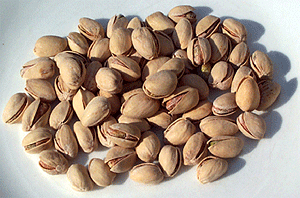What's a Health Nut?
Copper Applications in Health & Environment
Copper is an essential trace nutrient, and we need a small amount of it - at least 0.9 mg/day according to the National Academy of Sciences - in our diet to maintain good health. Green vegetables, fish, shellfish, nuts and even chocolate are good sources. When it comes to nuts, the California Pistachio Commission reminds us that a 1-oz serving - about 47 nuts, according the USDA - contains more than 10% of the minimum daily dietary copper requirement, as well as such other good things as dietary fiber, vitamin B-6, thiamin, magnesium and phosphorus. For the diet-conscious, the 1-oz serving contains 5.4 grams of carbohydrates, 5.5 grams of protein and 13 grams of fat, of which all but 1.5 grams are of the heart-healthy monounsaturated variety.
 Figure 1. Copper-rich health food
Figure 1. Copper-rich health foodAnd speaking of hearts, numerous studies point to a connection between copper and coronary health. (See Medical Uses of Copper in Antiquity, Copper: Human Health and " Copper and the Environment" for more information.) It's interesting that research cited by the CPC on its Web site suggests that eating nuts, including pistachios, also helps maintain healthy hearts. Enjoy.
Oh, in case you were wondering, it's chlorophyll, not copper that colors the nuts' kernels green.
Also in this Issue:
- What's a Health Nut?
- Will Copper Sop Up Radioactive Pollution
